This classic Italian basil pesto with pine nuts is the only recipe you’ll ever need! The secret? Chill your olive oil. Use small Genovese basil leaves. Blend in batches. What a difference!
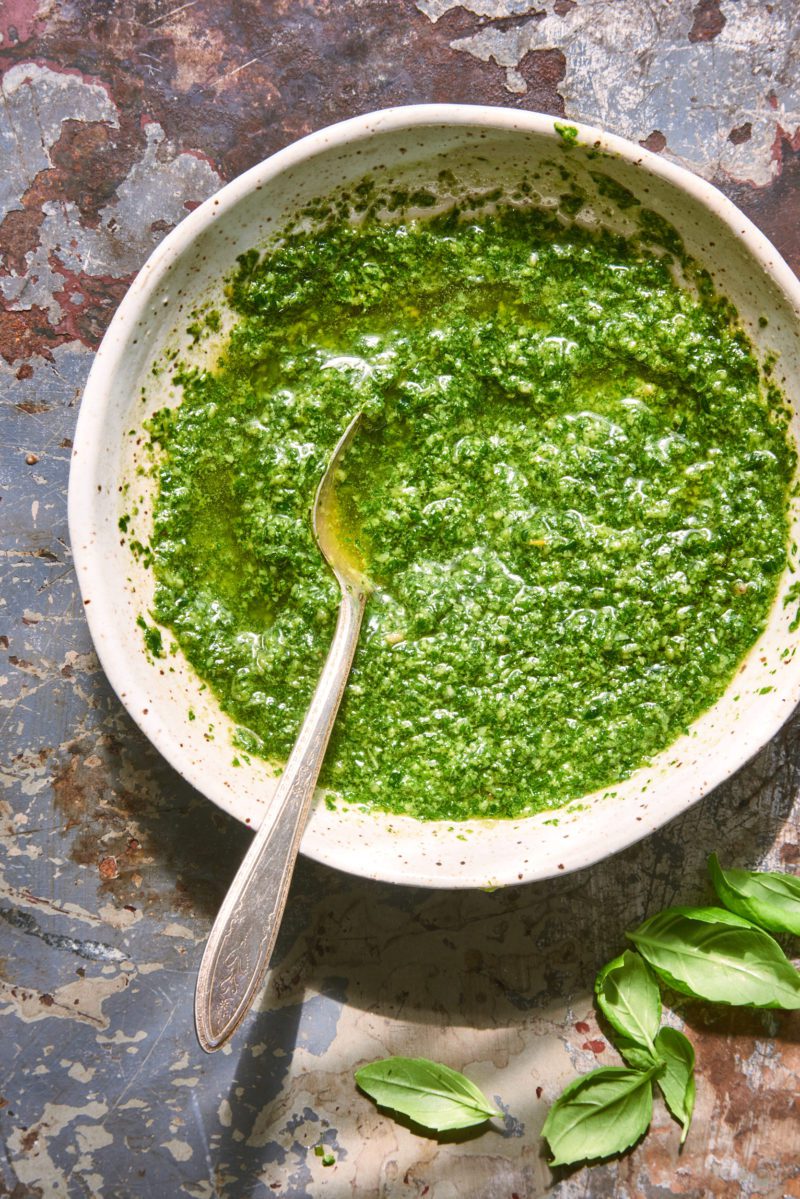
Truth be told: I’ve always struggled with basil pesto. Sometimes it was black. Other times, it was too garlicky. And more often than I’d like to admit, my prized homegrown basil leaves tasted like licorice! Why?
Curiosity lured me to the book Liguria by Laurel Evans, revealing clever tips and tricks I never knew before. For example: chilling the olive oil helps to keep the pesto bright green. Did you you know that? And choosing small, baby basil leaves instead of the gigantor ones are ideal for best color and flavor.
So, while most basil pesto recipes seem similar by nature, my recipe dives deeper emphasizing the importance of ingredient selection and method which sets it apart from the rest (wait until you read the tips!). Making classic Italian basil pesto is not just blending everything together like a smoothie. It’s an art.
Ok. So Tell Us More…
Pesto can be any blended “no- cook” sauce. For example: arugula + almonds + garlic + olive oil = arugula pesto. Swap the arugula for basil, throw in some tomatoes and now you have Pesto alla Trapanese (Sicilian Pesto). Or… swap the fresh tomatoes for sun dried tomatoes and make this 6-Ingredient Sun Dried Tomato Pesto. But the most famous pesto, the one we all know and love is Pesto alla Genovese.
What Is Pesto alla Genovese?
Originating from Genoa, the capital city of Liguria Italy, Pesto alla Genovese is made with fresh basil, garlic, pine nuts, salt, olive oil and hard cheese, traditionally Pecorino and Parmesan. It comes together quickly in a blender or food processor, while traditionalists might pound it by hand with a mortar and pestle- I am horrible at this.
Either way, this classic basil pesto recipe lasts up to 1 week in the fridge with a slick of olive oil on top to prevent oxidation. My Dad takes it a step further and adds a lemon slice (genius) to prevent browning. Serve with fresh homemade pasta and gnocchi, as a pizza sauce with fresh homemade ricotta (I have a version of this in my book: Artisan Sourdough Made Simple) or on grilled sourdough bread. I love it dolloped on minestrone soup too.
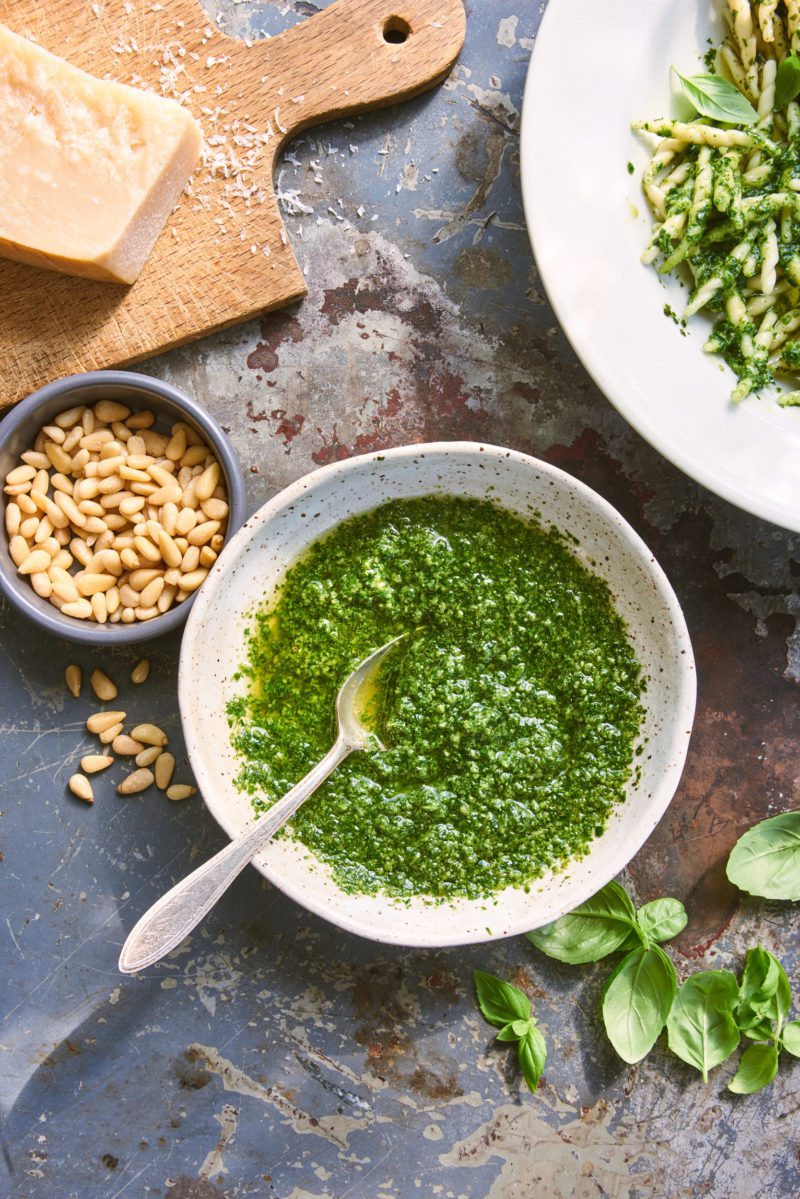
Want Bright Green Pesto? Read These Tips.
The biggest problem with homemade basil pesto is oxidation. And life’s too short for swampy brown pesto, wouldn’t you agree? The following tips come from Liguria by way of Enrica Monzani, a finalist at the World Pesto Championship. They are excellent.
- Chill the bowl and blade (food processor or blender). This prevents oxidation. Pesto can turn brown pretty quickly from the mechanical heat of the blades. Chill for at least 30 minutes (I actually freeze them).
- Chill your olive oil! Again, this helps with oxidation. 30 minutes in the fridge is sufficient.
- Blend in batches. The final texture is better this way. You’ll see.
- Use small basil leaves. Not the big ones that smell like mint! They’re too strong. You’re looking for basil stems no longer than 6 inches.
- Do you wash your basil? This removes some of its aromatic, essential oils (I didn’t know this). If doing so, use cold water and wash quickly. Do not soak for ages. Dry thoroughly in a salad spinner, and then lay flat on a clean kitchen towel to dry further. The leaves cannot be wet. PS: make sure to remove the stems too. They contain a lot of water.
Basil Pesto Ingredients: You Will Need
- Fresh basil
- Garlic
- Pine Nuts
- Olive oil
- Pecorino & Parmesan Cheese
- Salt
Fresh Basil: Choose small, baby, round-leafed basil leaves (Genovese variety) for best flavor. The smaller the leaves, the sweeter the taste. I cannot stress how important this is. The aroma is mild and delicate, and the color is bright and fresh. Look for small leaves that curl under like spoons- this is key.
If using older, more mature basil of a different variety the flavor will be completely different and possibly too strong like licorice (this was my initial problem with pesto). Purchase small basil bunches at the farmer’s markets or opt for potted plants instead. That’s what I do. Trader Joe’s carries excellent basil plants when in season.
Garlic: This needs to young and fresh. Look for tight garlic heads without those skinny green stems poking through. Too strong. Also: smell it. If the aroma is potent like garlic powder, it’s too old.
Pine Nuts: Their nutty, waxy texture adds the best creaminess to pesto, which I love. However, pine nuts are expensive (Trader Joe’s has the best price) and should be stored in the freezer (they spoil quickly due to its high fat content). I typically don’t recommend pine nut substitutions, because it changes the flavor. But in a pinch, use walnuts.
Extra Virgin Olive Oil: Is your pesto too bitter? Too dark in color? Or both? You’re most likely using the wrong olive oil. You’ll need a light and delicate extra virgin olive oil for basil pesto. I recommend the following brands you can easily find at the store: Lucini, California Olive Ranch and La Tourangelle. Comparatively speaking, a strong, peppery olive oil will wreck the sauce.
Cheese: The traditional cheese for classic basil pesto is Pecorino Fiore Sardo, a rich, sheep’s milk cheese with a subtle smoky taste. But this cheese is hard to find. Most recipes use a blend of Pecorino Romano and Parmesan cheese instead. The combo is delicious.
Salt: Go easy here because the cheese is salty. Just a pinch of sea salt will do. Always taste first.
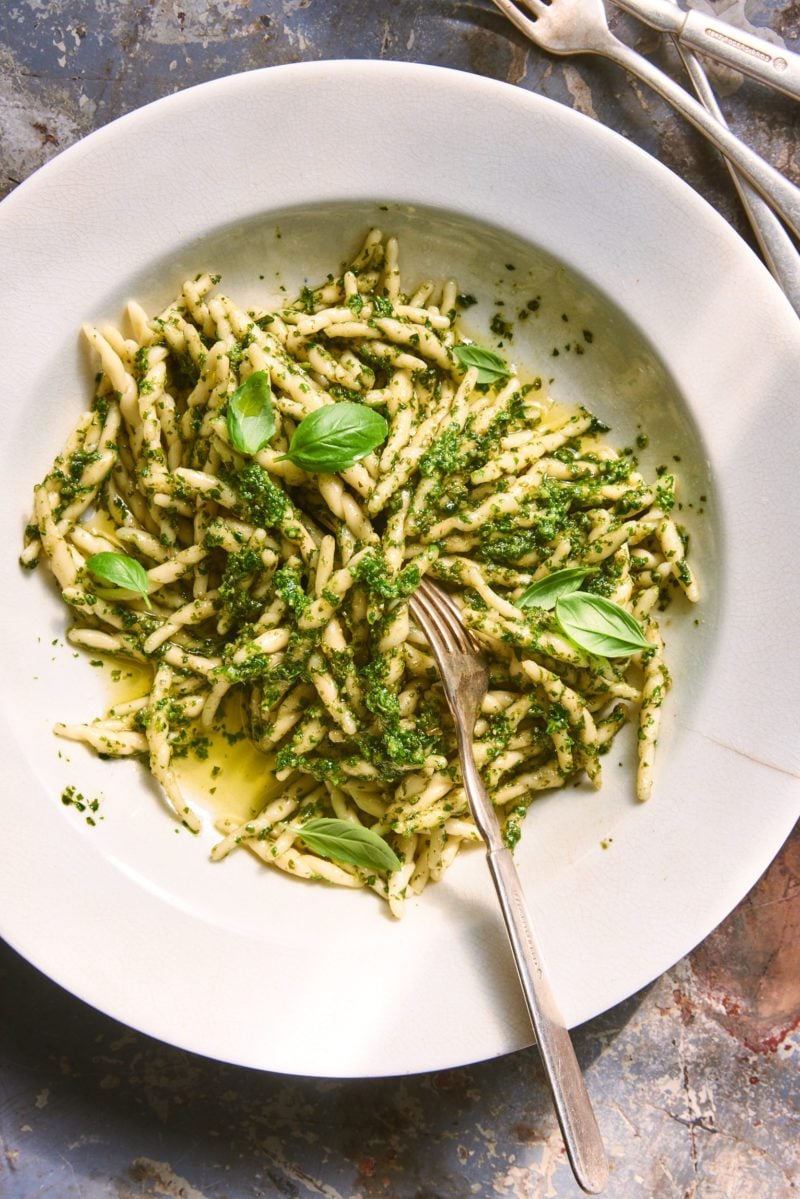
TIP: For the ultimate experience, serve fresh basil pesto with Trofie pasta. It’s a Ligurian classic!
Classic Italian Basil Pesto Pairs Well With:
- Fresh Homemade Pasta
- Fresh Homemade Gnocchi
- Fresh Pappardelle Pasta with Classic Basil Pesto
- Best Sourdough Pasta {1 Hour or Overnight}
- Sourdough Bread
- Sourdough Focaccia
- Ultra-Creamy Fresh Homemade Ricotta
More Pasta Sauce Recipes To Try!
- Ragù Bolognese Sauce
- Aglio e Olio (Garlic and Oil)
- 20-Arrabbiata Sauce
- Homemade Italian Sausage Ragù
- Quick Sicilian-Style Tomato Sauce
- Easy Golden Butter & Sage Pasta Sauce
- Authentic Pomodoro Sauce (Fresh or Canned)
- Pesto alla Trapanese (Sicilian Pesto)
- 6-Ingredient Sun Dried Tomato Pesto
- Creamy Béchamel Sauce (For Lasagna, Pasta & More!)
This post contains affiliate links. Photo credit & styling: Melina Hammer.
Print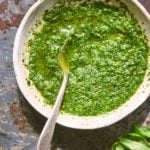
Classic Italian Basil Pesto (Pesto alla Genovese)
- Prep Time: 5
- Total Time: 5 minutes
- Yield: 1 cup
- Category: Pasta Sauce
- Method: No-Cook
- Cuisine: Italian
- Diet: Vegetarian
Description
A simple, classic Italian Basil pesto recipe with pine nuts. It comes together quickly in the food processor or blender. Make sure to read the helpful tips to prevent oxidation! Recipe adapted (with changes) from Liguria by Laurel Evans.
Ingredients
- 70 g (appx. 2 1/2 – 3 cups), small, basil leaves (see note)
- 1 fresh garlic clove, smashed and roughly chopped
- 3 tbsp. pine nuts
- 1/2 cup olive oil, divided, plus more as needed
- 6 tbsp. (packed) grated Parmesan cheese
- 2 tbsp. (packed) grated Pecorino cheese
- Pinch fine sea salt
Pesto Notes & Tips:
- For the basil: choose small, baby basil leaves (Genovese variety). This is key. Grab a few potted plants if you cannot find this basil in bunches. The leaves should be small and curl under. They are tender and delicious!
- For the olive oil: Light and delicate extra virgin olive oil is a must! Ligurian olive oil is excellent for pesto. It’s mild, fruity and it doesn’t overpower. Problem is, you won’t be able to find it in the store. Sub with a good-quality mild oil that’s not peppery or dark green in color (the flavor will be too strong, and the color will be too dark). I recommend: Lucini, California Olive Ranch and La Tourangelle.
- Blend the pesto in batches, per the recipe. Doing so, paired with chilling the food processor or blender bowl, blade and olive oil, helps to prevent the basil from bruising and turning black. You’ll also achieve the best texture and flavor.
Instructions
Before you begin: Freeze the bowl and blade of your food processor (or blender) for 30 minutes. Refrigerate the olive oil for 30 minutes. This will prevent the basil from oxidizing.
- Add the garlic, pine nuts and 2 tbsp. of oil to the food processor. Pulse a few times until minced. Scrape down the sides of the bowl.
- Add the basil leaves and another 2 tbsp. of oil. Pulse until finely chopped. Add the cheeses.
- With the machine running, slowly stream in the rest of the olive oil and blend until creamy. Scrape the pesto into a bowl.
- Taste, and adjust seasoning with salt (if needed). Stir in more olive oil to loosen the texture (if needed). It shouldn’t look like a thick glob.
- To store: transfer pesto to a small jar. Top with a layer of olive oil to prevent browning. Refrigerate until ready to use. It should last up to 1 week.
Note: if serving pesto with pasta, thin the pesto with a little bit of the pasta cooking water first. Otherwise, it won’t coat the pasta correctly- it will be too thick.
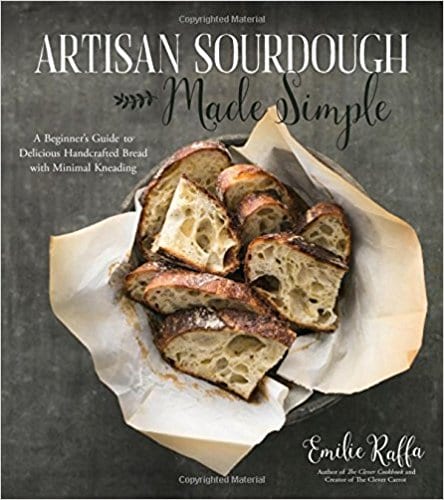

Comments
Scott Thompson says
You mentioned using a slice of lemon… Where is this incorporated in the recipe? Is it something blended into it… Or just placed on top of the layer of oil?
Emilie Raffa says
Hi there! Lemon is not used in the actual recipe. As a tip, my Dad places a slice on top of the pesto (in a jar) to prevent browning.
Janna says
I tried this recipe and it turned out really good. What else can I add to the recipe? Thanks for the recipe.
Emilie Raffa says
Fantastic! Ooo, that’s a good question. Not sure if I’d add anything else to the classic recipe… However, if you want to play around, consider adding some fresh parsley or walnuts instead of pignoli to change it up. Or try my Sicilian Pesto with tomatoes- that one is really good.
Ann says
Incredible!
Emilie Raffa says
Thank you! Glad you enjoyed it :)
Erin says
Thank you for these tips! I am allergic to pine nuts and walnuts. Do you have any suggestions of alternative nuts that have a similar taste? Would almonds be nutty enough? Thank you!
Emilie Raffa says
Hi Erin! Absolutely. Almonds work, although I wouldn’t toast them (if this even crossed your mind). The flavor would be too pronounced. Also: Brazil or Macadamia nuts would be nice; they naturally echo the creamy, waxy texture of pine nuts.
Sabrina says
thank you, wonderful tips, I have a recipe that I like but never chilled my olive oil or used small Genovese basil leaves, so definitely worth trying, much appreciated!
Emilie Raffa says
Oh yes! Definitely try it! I’m telling you, the chilling step works like a charm. You can apply it to any recipe.
Joseph Campisi says
Love it, I freeze some in ice cube trays, with out the cheese, use in I pot roast and other dishes. If I’m going to use it with pasta I then add the cheese.
Emilie Raffa says
Hi Joseph! I’ve never used pesto in pot roast before and it sounds outrageously good. I will be thinking about this for the rest of the day now- I’m hungry!
Renee G says
I always wondered how to keep it from turning brown. I tried sprinkling a little white wine vinegar which seems to help. I like the idea from Catmum’s comment, putting in baby jars! Looking forward to trying this method.
Emilie Raffa says
I know… pesky brown pesto is the worse. I’ve never heard of white wine vinegar tip before. So interesting… can you detect the flavor in the pesto?
catmum Piper says
We grow our own basil and garlic and look forward to making pesto every year. We use the small glass baby food storage containers with the airtight snap lids to freeze our pesto, this works well to keep it fresh and from browning, and means we can use these small portions easily. We also make zhoug with cilantro we grow and do the same thing (because it too will turn brown quickly)
Emilie Raffa says
Yes! We do the same. Small portions of frozen pesto can’t be beat. I love pesto in soup :)
Off topic, we are growing garlic for the first time this year. Do you have any tips? I’m so impatient, I want to pull it out of the ground now, lol.
claire piper says
If you were lucky enough to get any scapes, from hardneck garlic generally, those need to be cut off before the flowers bloom…and of course eat them, or make pesto. You want that energy diverted to the bulbs rather than making flowers and seeds. Even some softneck garlic will make scapes if it is slightly stressed or you are just lucky ;-)
Most of the time your garlic plants should have at least 6-8 fully formed green leaves (the leaves represent the layers of paper wrappers around the bulb). Let the soil dry a bit and then gently pull the soil back on a few bulbs to check how big the bulb is. If it is still too small, gently cover it back up and wait a week or so, then check again. If the bulb looks substantial, the wrappers tight, and the cloves well-formed, it’s ready to be pulled. A reliable harvest indicator is when half the leaves have died off, and half are still green. The leaves start to die off from the bottom up. When most of your crop has reached this stage (aim for at least 50 to 75 percent of your crop, assuming you planted them all at the same time), stop watering for at least a week and allow the soil to dry out a bit to prevent rot and make harvesting easier. If your soil is soft and loose, you can gently pull the plants out; you can also CAREFULLY use a potato fork to tease them out. Do NOT wash them. Brush the dirt off and hang the whole plants upside down someplace cool and dry for at least a couple weeks. The leaves will dry up, you can then braid them, or cut the leaves off. I store the heads in the basement in a slat-sided wooden crate, layered with crumpled paper, in the dark. Save the best heads to plant again in late August. We are in Saint Louis, and will probably be harvesting mid-to-late June. Different varieties and locations, of course, ymmv ;-) Good luck!
Angi says
Apparently when you plant your garlic in the fall, plant the largest cloves of garlic and it will insure that your heads are bigger. I haven’t tried this yet, but it makes sense.